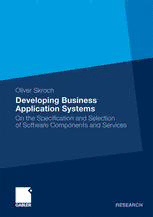Table Of ContentOliver Skroch
Developing Business Application Systems
GABLER RESEARCH
Oliver Skroch
Developing Business
Application Systems
On the Specifi cation and Selection
of Software Components and Services
RESEARCH
Bibliographic information published by the Deutsche Nationalbibliothek
The Deutsche Nationalbibliothek lists this publication in the Deutsche Nationalbibliografi e;
detailed bibliographic data are available in the Internet at http://dnb.d-nb.de.
Dissertation Universität Augsburg, 2009
1st Edition 2010
All rights reserved
© Gabler Verlag | Springer Fachmedien Wiesbaden GmbH 2010
Editorial Offi ce: Ute Wrasmann | Britta Göhrisch-Radmacher
Gabler Verlag is a brand of Springer Fachmedien.
Springer Fachmedien is part of Springer Science+Business Media.
www.gabler.de
No part of this publication may be reproduced, stored in a retrieval system
or transmitted, in any form or by any means, electronic, mechanical, photo-
copying, recording, or otherwise, without the prior written permission of the
copyright holder.
Registered and/or industrial names, trade names, trade descriptions etc. cited in this publica-
tion are part of the law for trade-mark protection and may not be used free in any form or by
any means even if this is not specifi cally marked.
Umschlaggestaltung: KünkelLopka Medienentwicklung, Heidelberg
Printed on acid-free paper
Printed in Germany
ISBN 978-3-8349-2350-9
Preface
The urge for a better, cheaper, and faster developmentandtailoring ofapplication software
systemscanbeexplainedbytheirhigh importance:well-workinginfonnationprocessingisa
requiredpreconditionfortheprosperity- orevenforthemeresurvival-ofmanybusinesses
and institutions. Hence it is a highly warrantable and topical objective to significantly
irnprove software development by new technologies and methods, to increase quality and
benefits while at the same time decreasing lifecycle costs and project durations. Where,
however, are reasonable starting points for research activities thatpursue these objectives?
Software reuse and in particular the closely related component- and service-orientation are
among the few fundamental approaches thatshow greatest promise. This bookpresents six
respectiveresearcharticles.
Thebookisbasedon mycumulativedoctoralthesis and Ifeel indebted to manypeopleand
theirsupport.IthankProf.Dr.KlausTurowskiinthefirstplace.Heenabledmyintegrationas
an external researcher at the Chair of Business Informatics and Systems Engineering,
UniversitätAugsburg,andheprovidedmostvaluablesupportindecisivesituations.Igivemy
thanks to Prof. De. Robert Klein for thesecond opinionon my dissertation and to Prof. De.
AxelTumaforpresidingthe disputation. Iam grateful to my co-authorsDe. SvenOverhage
andMichaelProBforthegood,successful,andpleasantteamworkonourresearcharticles.
Finally, I am happy to acknowledge the support ofmany good and unnamed spirits both in
my private and professional world. You were always able 10 show understanding for my
researchandyoutoleratedthevastamountoftimeandeffortthatIdedicatedtoscience- you
onlycamesecondsooftenandalthoughyouhavedeservedtocomefirstjustasweil.
Augsburg,February2010 OliverSkroch
Contents
Preface v
Contents vii
Listoffigures xi
Listoftables xiii
Abbreviations xv
Symbols xvii
Introduction 1
1.1 Motivationandchallenges 1
1.2 Objectivesandfocalresearchquestions 6
1.3 Classificationandorganization 9
References 13
II Strategicframework 15
ILRI Atheoryofsoftwarereusestrategiesinidealtypestableandturbulent
marketenvironments 17
1 Introductionandobjectives l8
2 Basicsoftwarereuseoptions 20
2.1 Compositionalreuse- buildingblocks 21
2.2 Generativereuse- solutionpatterns 21
3 Twoidealtypemarketenvironmentsandtheirbusinessstrategy 22
3.l Traditionalenvironments- defenders 23
3.1.1 Defensiveinternalimprovernentstrategies 23
3.1.2 Defenders'dilemma 24
3.2 Turbulentenvironments- prospectors 25
3.2.1 Prospectiverapidadaptationstrategies 25
3.2.2 Prospectors'dilemma 26
4 Supportingexperience:projectsfrompractice 27
4.1 Stableenvironment- frauddetection 27
4.2 Turbulentenvironment- softwaresimulator 27
4.3 Hybridenvironment- portalarchitecture 28
5 Concludinghypotheses,lirnitationsandfurthersteps 28
References 30
II.R2 Integrationassessmentofanindividuallydevelopedapplicationvs.software
packagesfromthemarket- anexperiencereport 33
1 Introductionandsetting 34
2 Projectapproachandselectedresults 36
2.1 Functionalcomparisonofavailablepackages 37
2.2 Integrationscenariocasestudies 39
viii Contents
3 ConclusionandremarIes 43
References 43
III Specification 45
IILR3 TheimportanceofrequirementsspeciflcationsforsuccessfullTprojects 47
1 Requirernentsspeciflcationsinthedevelopmentprocess 48
2 Successfactors 48
2.1 Systernaticapproach 49
2.2 Detailedanalysisanddocwnentation 50
2.3 Realisticeffortestimations 51
2.4 Integrationofmissingexpertise 51
2.5 Coordinationandalignment. 52
2.6 Jointandactiveorganization 52
2.7 Efficientchangemanagement.. 53
3 Risks 53
3.1 Disputedandincomp1etescopeofwork 54
3.2 Delay 55
3.3 Additionalcosts 55
3.4 Legaldispute 56
4 Futurerequirements 57
References 57
IILR4 Amethodtoevaluatethesuitabilityofrequirementsspecificationsfor
offshoreprojects 59
1 Motivation 60
2 Backgroundandrelatedapproaches 62
2.1 Outsourcing,offshoring,andapplicationdevelopmentbased
onthedivisionoflabor 62
2.2 Theirnportanceofrequirementsspecificationsforoffshoring 63
2.3 Evaluationapproachesfurrequirementsspecifications 63
3 Conceptualbasics 64
3.1 Specificationquality 65
3.2 Compensationfactors 66
4 Designoftheevaluationmethod 68
4.1 Procedurefordeterminingthespecificationquality 68
4.2 Procedurefordeterminingthecompensationoptions 69
4.3 Furtherrefmementoftheevaluation 70
5 Evaluation 71
5.1 Determinationofthespecificationquality 71
5.2 Determinationofthecompensationpossibilitiesandoptions
foraction 73
Contents ix
5.3 Receptionoftheresults 74
6 Conclusion 75
References 76
IV Selection 79
IV.R5 Optimalstoppingfortherun-timeself-adaptationofsoftwaresystems 81
I Introduction 82
2 Flexiblesoftwarearcbitecturesandmatcbingschernesforself-adaptation 83
3 Optimalstoppingintwoself-adaptationscenarios 85
3.1 Limitednumberofrun-timeoptions 85
3.2 Limitedrun-timedelay 86
4 Applicationandsimulation 87
4.1 Limitednumberofrun-timeoptions 87
4.2 Lirnitedrun-timedelay 88
5 Summaryandconclusion 90
References 90
IV.R6 Reducingdomainlevelscenariostotestcomponent-basedsoftware 91
I Introduction 92
2 BasicassumptionsandbusinessmodeL 93
3 Constructinglinearscenarios 96
3.1 ARIvaloverview 96
3.2 Processt10wtransformationandblocking 98
3.3 Example 102
4 Relatedwork 106
5 Summaryandconclusions 108
References 109
V Conclusionsandoutlook 113
V.I Conclusions 113
V.2 OUtlook 116
References 117
Listoffigures
I-I "TripieConstraint" I
1-2 Organizationofthisbook 10
ILRI-l Strategieoptionsinthemuiti-pathprocessmodel 19
II.R2-1 Multi-pathprocessmodel 35
II.R2-2 Functionalevaluation,availablepackagesvs. individualsolution 38
ILR2-3 Sevencasestudiesofsoftwareintegrationscenarios 40
III.R3-1 SuccessfactorsfOTclearrequirementsspecifications 49
III.R3-2 Risksfromunclearscopeofworkdescriptions 54
III.R4-1 Relationbetweenthespecificationqualityandimplementationrisks 65
III.R4-2 Two-stage,qualitativeevaluationprocesstodetermineqj 69
IV.R5-1 Componentsoftwarearchiteetureexarnple 83
IV.R5-2 Possiblematchingschemes 84
IV.R6-1 Businessmodelassumption 94
IV.R6-2 ARIvaloverview 96
IV.R6-3 Sequenceblocking 99
IV.R6-4 Splittransformationandblocking 100
IV.R6-5 Jointransformationandblocking 101
IV.R6-6 Iterationtransformationandblocking 101
IV.R6-7 Domainmodelexcerpt 103
IV.R6-8 Behavioralspecificationartifact(OCL) 104
Listoftables
lI.Rl-l Fundamentalreusestrategies 20
lI.RI-2 Twoidealtypemarketenvironments 23
ILRI-3 Reuseoptionsandmarketplayers 29
III.R4-1 Processstepsofapplicationdevelopment(simplified) 62
III.R4-2 Compilationofcompensatingfactorsinoffshoreprojects 67
III.R4-3 Graphicalrepresentationofexpectedcompensationefforts(exarnple) 70
III.R4-4 Identifiedcompensatingfactorsandbalancingeffects 73
IV.R5-1 Resultsfromsimulationexperimentsforthe"limitedoptions"scenario 88
IV.R5-2 Resultsfromsimulationexperimentsforthe"limiteddelay" scenario 89
IV.R6-1 Partitionsandvalues 103
IV.R6-2 "Sunshinepath"sequences 104
IV.R6-3 Relatedapproaches 106

